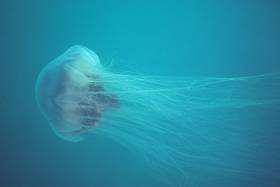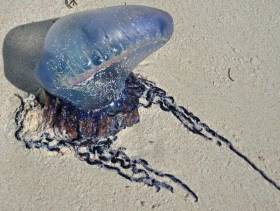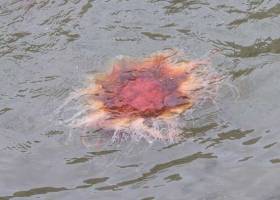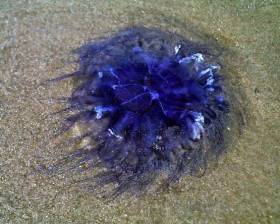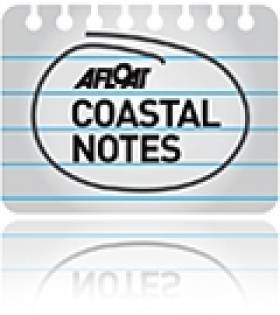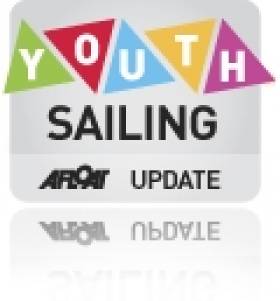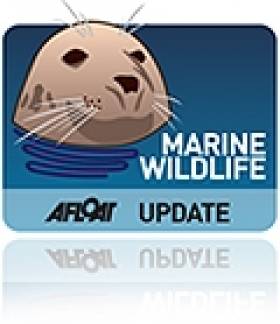Displaying items by tag: Jellyfish
Lion’s Mane Jellyfish Warning For Dublin Bay
#Jellyfish - Swimmers have been warned away from Seapoint and Sandycove on the south shores of Dublin Bay after sightings of potentially dangerous lion’s mane jellyfish in the water.
Dun Laoghaire-Rathdown County Council has put up warning signs in the relevant areas to advise the public on the large jellyfish, whose stings from hundreds of tentacles can cause anaphylactic shock — even many days after they have beached.
Mauve Stinger Jellyfish Beach In Their Thousands On Co Clare Strand
#Jellyfish - Mauve jellyfish have stranded in what could be record numbers in Co Clare.
Thousands of the species Pelagia noctiluca, also known as the mauve stinger, have beached at Fanore since last Friday (30 September) as photographed by local man Liam McNamara.
"This is the first time I've experienced mauve jellyfish in such numbers and I've been beachcombing for 40 years,” McNamara told Independent.ie.
"I'm not sure what's going on with our seas but definitely lots more jellies around.”
The surprising incident comes just days after hundreds of Portuguese man o’ wars began stranding at coastal spots along the Wild Atlantic Way between Kerry and Donegal in what’s thought to be the largest infestation in over a century.
Irish Water Safety says unusually warm sea temperatures have brought what are typically tropical species in droves to Irish waters.
Portuguese Man O'War Jellyfish is Largest Infestation In A Hundred Years – Water Safety
Irish Water Safety (IWS) is alerting the public to exercise caution on our south, west and northwest coastline over the next few days due to jellyfish arriving on our shores, as previously reported by Afloat.ie.
IWS says Ireland has experienced tropical maritime air for almost two months now with very little northerly winds, in addition sea water temperatures are approximately 15 degrees Celsius, consequently we have seen one of the largest infestations of the Portuguese Man o'war land on our western seaboard in over a hundred years.
There is a new moon on Saturday which will give us spring tides which will mean that we will have larger exposed areas of coastline where we are likely to see these most venomous siphonophores or to most of us Jellyfish. Surfers, kite surfers, swimmers, kayakers, divers and walkers need to keep a vigilant eye open for these creatures which give a very strong sting and to some people can cause anaphylactic shock or seizures. Local Authorities from Cork, Kerry, Clare, Galway, Mayo and Donegal have reported them on their shores mainly in south and southwest facing bays. There have been reports of in excess of 80 landing on the South Harbour in Cape Clear an in excess of 20 on Keel Bay in Achill. They have been known to kill people such is the severity of their stings.
- Ensure you don't get stung yourself when aiding others.
- Remove any attached tentacles with a gloved hand, stick or towel.
- Do not rub the affected area, this may result in further venom release.
- Rinse the affected area with sea-water (do not use fresh water, vinegar or urine)
- Apply a "dry cold pack" to the area (i.e place a cold pack or ice inside a plastic bag & then wrap this package in a t-shirt or other piece of cloth).
- Seek medical attention if there is anything other than minor discomfort (Please note: The sting can cause anaphylactic shock, if you are feeling unwell go to A&E for treatment).
Members of the public should report the sightings of these two jellyfish to the relevant Local Authority or local Water Safety Development Officer
Triathlon Under Threat From Dangerous Jellyfish In Sandycove
#Jellyfish - Organisers of tomorrow's Ironman triathlon in Dublin Bay are currently monitoring the appearance of Lion's Mane jellyfish in the waters of the swimming course.
According to The Irish Times, the Ironman event is scheduled to begin early on Sunday 14 August with a 1.9km swim across the bay from Sandycove, which has been red-flagged since Wednesday after a number of the dangerous jellyfish washed up on the beach.
The Lion's Mane's powerful sting is known to cause anaphylactic shock, which is potentially fatal – and the sting is still potent even days after a jellyfish has died, as previously reported on Afloat.ie.
Lions Mane Jellyfish Appearing on Irish Beaches
The potentially dangerous Lions Mane Jellyfish which is being washed up on Irish beaches can cause anaphylactic shock.
So far this summer the jellyfish has washed up on beaches at Portmarnock, Malahide, Sutton and Bettystown.
The Irish water safety CEO, John Leech, says 'more jellyfish are likely to appear on our beaches in the coming weeks'.
'The sting from these jellyfish can cause anaphylactic shock and we have had a number of people hospitalised as a result of a sting from these venomous Jellyfish', Leech adds.
The sting from their tentacles lasts many days after they have died.
Members of the public should report the sightings of these two jellyfish to the relevant local Authority Water Safety Development Officer here
For those who will be using non-lifeguarded beaches then download information on jellyfish, including a photo ID card and First Aid treatment of stings here
Jellyfish Warning For Sandycove Beachgoers
#Jellyfish - Dún Laoghaire-Rathdown County Council has raised the red warning flag in Sandycove and erected signs warning swimmers of the presence of stinging jellyfish in the water and washed up on the beach. Photographs have been taken and sent off for expert identification of the marine species.
Dead Jellyfish On Galway Beach Still Pack A Sting, Experts Warn
#Jellyfish - Summer may be long gone, but jellyfish attracted by the warmer waters of recent months are still posing a hazard on Galway's beaches, as the Connacht Tribune reports.
Recent weeks have seen Salthill strewn with the remains of hundreds of dead mauve stingers, which can still pack a punch even after death.
Meanwhile, though marine science boffins are not surprised by the sheer numbers of the seaborne creatures in Galway Bay as this period is their mating season, they are concerned that so many are being washed ashore.
The jellyfish warning comes not long after Fáilte Ireland's falling afoul of locals for advising against bathing at Salthill's popular strand.
While recommending the city suburb's famous promenade for walking and sightseeing, the tourism board's Discover Ireland website reportedly stated that "swimming is not recommended" at the adjacent beachs.
No reasons were given for this advice, which has raised the ire of locals including Labour Party city councillor Niall McNelis, who said: “I cannot understand why Fáilte Ireland would warn people not to swim in Salthill. It has a Blue Flag."
Jellyfish Wipes Out First Race of Dublin's Junior Sailing Series
#Dublin Bay junior sailors turned up to race yesterday on what was arguably one of the best sailing days of the season so far only to learn the first race of their September Series was scubbed due to 'jellyfish reasons'.
It's just the latest shut down of leisure pursuits in the capitals waters after Dun Laoghaire Rathdown County Council warned against bathing in 'Jelly fish infested waters' at nearby Sandycove.
As a finale to the 2014 season, racing was scheduled for six dinghy classes including the Optimist, Laser Radial and 4.7, Topper, Feva and 420 classes but not even the fact that over 100 junior sailors drawn from the four dun Laoghaire yacht clubs would be on the water rather than in it could stop yesterday's cancellation of the harbour races, such is the risk posed by the Lions mane jellyfish.
Last week Dun Laoghaire Harbour Master Simon Coate wrote to the yacht clubs and classes. ' A considerable number of Lions mane jellyfish have been sighted within the harbour. Please warn your members,' Captain Coate advised.
Dangerous Jellyfish Removed From Dublin Beach
#Jellyfish - The Irish Mirror reported on Friday that 17 dangerous lion's mane jellyfish were removed from Sandycove Beach on south Dublin Bay.
However, that may be just the tip of the iceberg in their numbers as the giant venomous species flocks to Ireland's warming coastal waters from elsewhere in the Irish Sea.
Meanwhile, restrictions on bathing have been lifted from nearby Sandycove Harbour and Killiney Beach after elevated bacterial levels were detected in the water earlier in the week.
Dollymount Strand's temporary bathing ban has also been lifted, as have a number of advisories in North Co Dublin.
However, precautionary notices remain at three locations – Burrow in Sutton, Claremont in Howth and Loughshinny Beach between Rush and Skerries – due to poor results of samples collected from outfalls at those locations.
Girl Suffers Severe Reaction To Man O'War Sting In West Cork
#Jellyfish - West Cork on Thursday (7 August) saw a young girl treated for a severe allergic reaction to a jellyfish sting, as previously reported on Afloat.ie.
The Irish Examiner has more on the story of the girl aged between 10 and 12 who's believed to have come in contact with a Portuguese man o'war or similar stinging sea creature at Goleen beach.
Within minutes of the incident the girl was vomiting, spasming and suffering severe difficulty with breathing in what Goleen Coast Guard officer-in-charge Michael O'Regan called a "vicious reaction".
"After 50 years, I thought I'd seen everything," he told the Examiner. "I've done about 30 first aid courses over the years but have never come across anything to prepare us for something like this."
Sightings of dangerous jellyfish in Ireland's warming coastal waters since the beginning of last week have prompted warnings from water safety officials.
These warnings have been reiterated since the predicted arrival of the giant lion's mane jellyfish, which has been spotted off Sutton in North Dublin.


























